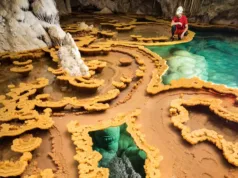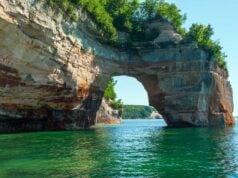Al Naslaa Rock is a unique geological formation located in the deserts of Saudi Arabia. It is renowned for its striking appearance, characterized by a massive sandstone block that appears to be split cleanly in two, almost as if by a laser or some other precise cutting tool. This remarkable natural wonder has captivated the imaginations of scientists, geologists, and tourists alike due to its mysterious and seemingly impossible formation.

The rock is situated in the Tayma Oasis, which is part of the Tabuk region in northwestern Saudi Arabia. It is a relatively remote and arid area surrounded by the vast expanse of desert, and it has become a popular destination for those interested in geology, archaeology, or simply intrigued by the enigmatic beauty of Al Naslaa Rock.
The most intriguing aspect of this rock formation is the perfect and seemingly symmetrical split down the center, which has led to various theories and speculations about how it came to be. Some suggest natural processes like erosion and stress fractures, while others entertain the idea of human or extraterrestrial involvement. Despite the ongoing debates, Al Naslaa Rock continues to be a subject of fascination and wonder for anyone who encounters it.
Geological Formation of Al Naslaa Rock
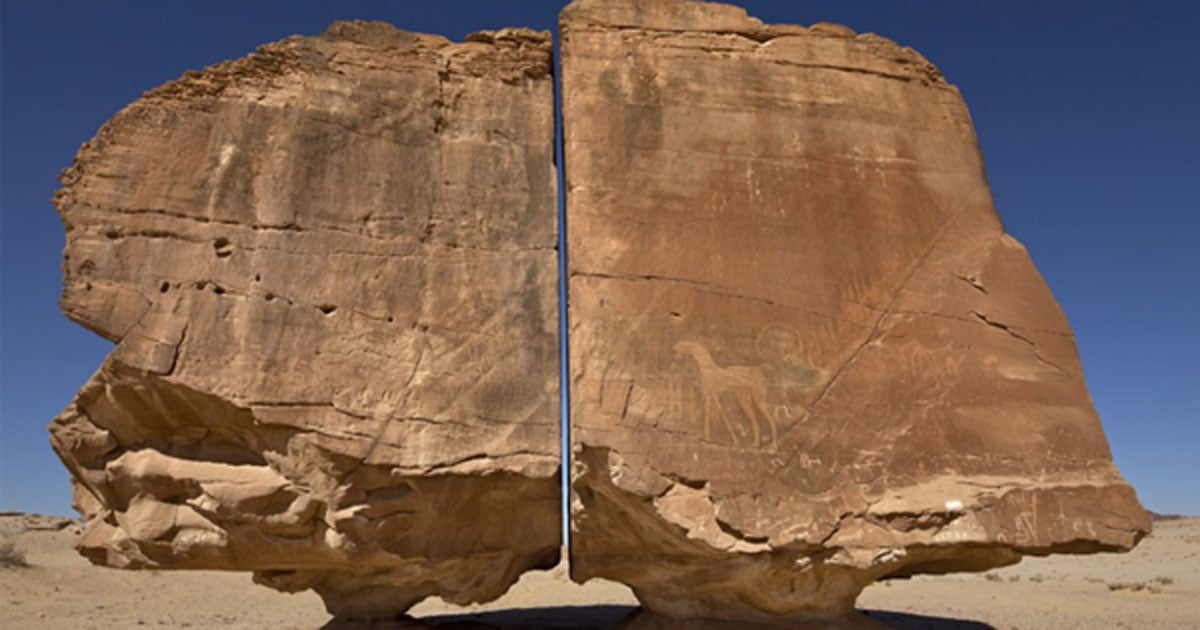
The formation of Al Naslaa Rock is a subject of geological curiosity and debate. While there is no definitive explanation for its creation, several theories have been proposed to account for this unique natural wonder. Here are some of the leading hypotheses:
- Natural Geological Processes: Many geologists believe that Al Naslaa Rock’s split and its striking appearance are primarily the result of natural geological processes. One prevailing theory suggests that the rock was formed from sandstone, which is known for its layering. Over millions of years, a combination of factors like erosion, weathering, and the shifting of tectonic plates might have caused stress fractures and the eventual cleaving of the rock along its natural fault lines. This process could have resulted in the rock splitting neatly in two.
- Exogenic Factors: Wind, rain, and temperature variations can contribute to the weathering of rocks. It’s possible that Al Naslaa Rock’s split was exacerbated or facilitated by these external factors over an extended period. Wind-blown sand, for example, could have acted as an abrasive agent, gradually eroding the rock along the fault lines.
- Tectonic Activity: The Tayma Oasis region where Al Naslaa Rock is located is not immune to tectonic activity. It’s conceivable that movements in the Earth’s crust and the forces of compression and tension have played a role in shaping the rock, causing it to eventually split.
- Alternative Theories: Some more imaginative theories have emerged, suggesting that the rock’s split might be the result of human or even extraterrestrial intervention, though these ideas lack scientific support and are generally considered highly unlikely.
What makes Al Naslaa Rock stand out are its distinctive features:
- Perfect Split: The most remarkable characteristic of Al Naslaa Rock is the precision and symmetry of its split. The two halves appear as though they were cut with remarkable accuracy, which adds to the rock’s mystique.
- Balanced Position: Both halves of the rock stand upright and are perfectly balanced on small pedestals, defying the laws of gravity and equilibrium.
- Remote Location: Al Naslaa Rock is situated in a relatively remote desert region, making it an isolated and awe-inspiring geological formation surrounded by vast arid landscapes.
Despite ongoing scientific inquiry, the formation of Al Naslaa Rock remains an enigmatic marvel, with its origins continuing to be the subject of both fascination and debate among geologists and enthusiasts.
Split Rock Mystery of Al Naslaa Rock
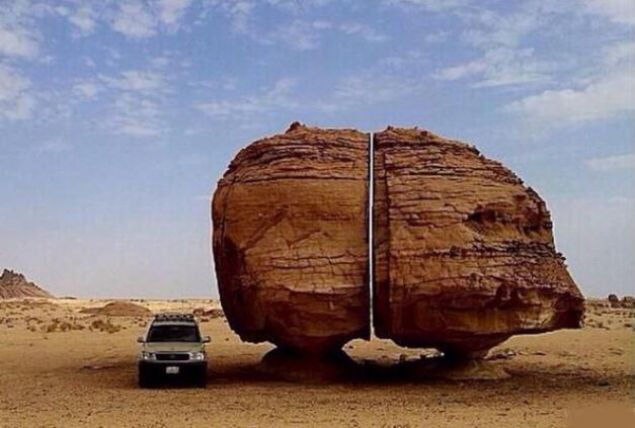
The enigmatic split in Al Naslaa Rock is a source of fascination and mystery, as it appears to have been cleaved with remarkable precision. Numerous theories have been proposed to explain this intriguing feature, although no single theory has been definitively proven. Here are some of the leading theories:
- Natural Weathering and Erosion: Many geologists believe that the split in Al Naslaa Rock is the result of natural weathering and erosion over millions of years. Sandstone, the type of rock that Al Naslaa is composed of, is known for its layering and natural fault lines. It’s possible that a combination of wind, rain, temperature fluctuations, and geological forces caused stress fractures to develop along these existing lines, ultimately leading to the rock splitting neatly in two. This theory suggests that the precision of the split is due to the pre-existing weaknesses in the rock’s structure.
- Tectonic Activity: The region in which Al Naslaa Rock is located has experienced tectonic activity. Some suggest that movements in the Earth’s crust, including compression and tension forces, could have contributed to the rock’s splitting. These geological forces might have accentuated existing weaknesses in the rock’s structure.
- Frost Wedging: Frost wedging is a geological process where water seeps into cracks in rocks, freezes, and expands, causing the cracks to widen and potentially lead to the splitting of rocks. In the arid desert environment where Al Naslaa Rock is located, extreme temperature variations between night and day could have contributed to frost wedging, eventually causing the rock to split.
- Human or Extraterrestrial Involvement: Some more speculative theories propose that the split in Al Naslaa Rock could have been created by human or extraterrestrial intervention. Proponents of these theories point to the precision of the split and the absence of clear geological evidence as reasons to consider alternative explanations. However, these ideas lack credible scientific support and are generally considered highly unlikely.
- Rapid Water Erosion: Another theory suggests that rapid water erosion, such as a sudden and intense flash flood, may have contributed to the rock’s splitting. While this might explain the clean break, it doesn’t address the precise symmetry of the split.
Despite the various theories, the exact cause of the split in Al Naslaa Rock remains a subject of ongoing geological investigation and debate. It continues to be a captivating geological mystery, drawing the attention of scientists, geologists, and curious visitors who are intrigued by the rock’s extraordinary and precise division.
Ancient Petroglyphs
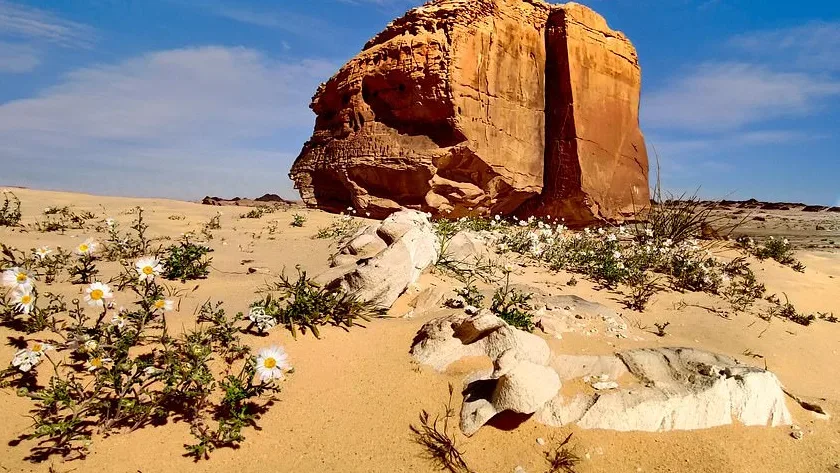
Petroglyphs and rock art can be found in the vicinity of Al Naslaa Rock, adding to the historical and cultural significance of the region. These ancient carvings and paintings provide valuable insights into the people who once inhabited or visited the area. While not as well-documented as some other rock art sites, such as those in the Sahara or North America, these petroglyphs near Al Naslaa Rock are an important part of the archaeological and cultural heritage of Saudi Arabia.
- Historical Significance: The petroglyphs in the region around Al Naslaa Rock are believed to date back thousands of years, possibly to prehistoric times. They serve as a tangible link to the past, offering glimpses into the lives, beliefs, and activities of ancient people who once inhabited or passed through this area.
- Cultural and Religious Depictions: Many of the petroglyphs feature depictions of animals, hunting scenes, and human figures. Some may also depict religious or spiritual symbols that were significant to the cultures that created them. These carvings and paintings are valuable for understanding the cultural and religious practices of ancient societies.
- Astronomical and Geometric Symbols: Some of the petroglyphs may incorporate astronomical symbols or geometric patterns. These could have been used for navigation, tracking celestial events, or as part of rituals related to the sky and cosmos. Deciphering these symbols can shed light on the knowledge and practices of ancient astronomers and mathematicians.
- Communication and Storytelling: Petroglyphs often served as a form of communication and storytelling for ancient people. They could depict important events, tales of conquests, or migrations. Researchers analyze these carvings to decipher the narratives and histories of the cultures that created them.
- Cultural Diversity: The diversity of petroglyphs in the region indicates that various cultures and communities have contributed to this rich tapestry of rock art over time. Studying the different styles and subjects of the petroglyphs can provide insights into the interactions and exchanges between these groups.
- Conservation and Preservation: The protection and preservation of these ancient petroglyphs are of paramount importance. Vandalism and natural wear and tear pose threats to their longevity. Saudi Arabia, like many other countries with rock art sites, is working to safeguard and document these valuable historical and cultural resources.
While the exact age and cultural affiliations of the petroglyphs near Al Naslaa Rock may still be topics of research and study, they are a testament to the enduring human desire to record and communicate their experiences, beliefs, and histories through art. These ancient carvings and paintings serve as a bridge connecting the modern world with the rich heritage of those who once inhabited the deserts of Saudi Arabia.
Tourism and Conservation

Al Naslaa Rock has indeed become a tourist attraction due to its unique and enigmatic geological features. Visitors from around the world are drawn to this remote desert location in Saudi Arabia to witness the remarkable split rock formation and the surrounding desert landscape. The influx of tourists has brought both opportunities and challenges, and efforts are in place to preserve and protect the site.
Tourism at Al Naslaa Rock:
- Visitor Interest: The striking appearance and mystery surrounding Al Naslaa Rock have led to a growing interest in the site. Tourists, nature enthusiasts, geologists, and photographers are among those who visit the area to witness this natural wonder.
- Local Economy: The increasing popularity of Al Naslaa Rock has contributed to the local economy, as it provides opportunities for tourism-related businesses, such as tour guides, accommodations, and restaurants, to thrive in the region.
Conservation and Protection Efforts:
- Access Control: To protect the site from over-tourism and potential vandalism, access to Al Naslaa Rock is often controlled. Visitors may need to obtain permits or be accompanied by authorized guides to access the area. This helps manage the number of people visiting the site and minimizes potential harm.
- Educational Initiatives: Local authorities and conservation organizations often engage in educational programs to raise awareness about the importance of preserving Al Naslaa Rock and its surroundings. These programs may target both locals and tourists, emphasizing responsible and respectful behavior.
- Infrastructure Development: Constructing well-maintained pathways, viewing platforms, and other visitor facilities can help reduce environmental impact by concentrating foot traffic and preventing erosion around the rock. Proper infrastructure also enhances the visitor experience.
- Regulations and Enforcement: Regulations may be put in place to prohibit activities that could harm the site, such as climbing on or defacing the rock. Enforcement of these regulations is essential to discourage destructive behavior.
- Monitoring and Research: Consistent monitoring and research into the geological and environmental conditions of Al Naslaa Rock and its surroundings can inform conservation efforts. Understanding how natural processes and human impact affect the site is critical for preservation.
- Collaboration with Indigenous Communities: Working closely with indigenous or local communities in the area is vital. Their knowledge of the land, cultural significance, and historical context of the site can contribute to responsible management and conservation efforts.
- Sustainability Initiatives: Promoting sustainable tourism practices, such as waste management and eco-friendly accommodations, can minimize the ecological footprint of visitors and contribute to long-term preservation.
Balancing tourism and conservation at Al Naslaa Rock is an ongoing challenge. While tourism can bring economic benefits to the region, it must be managed carefully to protect the geological wonder and the fragile desert ecosystem. Collaborative efforts among government authorities, local communities, and conservation organizations are essential to ensure that Al Naslaa Rock remains a natural treasure for future generations to appreciate and study.
Cultural and Mythological Significance of Al Naslaa Rock
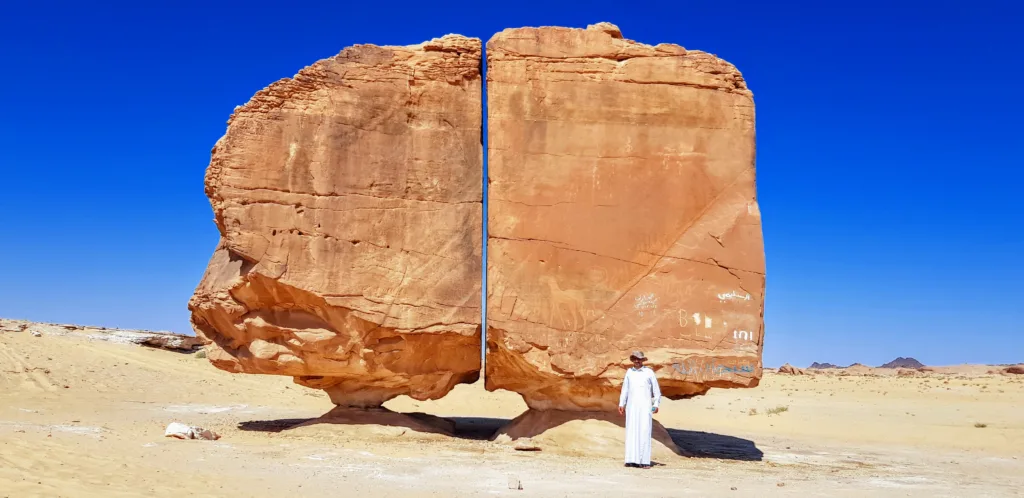
Al Naslaa Rock holds cultural and mythological significance, particularly among indigenous peoples in the region. While it may not have a well-documented mythology like some other natural landmarks, its unique appearance and location in the desert have likely led to various local beliefs and stories. Here are some aspects of its cultural and mythological significance:
- Local Folklore: In desert regions, large rock formations often feature in local folklore and legends. Al Naslaa Rock may have been the subject of such stories, passed down through generations. These stories might explain the split in the rock or attribute it to supernatural or mythological forces.
- Symbolic Significance: The striking appearance of Al Naslaa Rock, with its two perfectly balanced halves, could have symbolic significance in local cultures. It might represent ideas of balance, unity, or duality, and be incorporated into rituals or ceremonies.
- Possible Archaeological Significance: While not confirmed, the area around Al Naslaa Rock could have archaeological sites that hold cultural significance. These sites may contain artifacts, petroglyphs, or inscriptions that provide clues about the beliefs and practices of the ancient people who inhabited the region.
- Astronomical and Navigational Uses: The rock’s unique geometry could have made it a valuable landmark for indigenous peoples for navigation or astronomical observations. It might have been used to mark certain celestial events or to guide travelers in the desert.
- Cultural Identity: Al Naslaa Rock could hold cultural significance as a point of identification and pride for the local community. It may be considered a symbol of the region and its history.
- Pilgrimage or Ritual Sites: There is the possibility that Al Naslaa Rock or the surrounding area was used as a site for rituals, ceremonies, or even pilgrimage by indigenous cultures. The rock’s unique features could have been seen as sacred.
- Sacred Geometry: Some cultures ascribe spiritual or mystical significance to geometric patterns and shapes. The symmetry and precision of the rock’s split may have been seen as embodying sacred geometry principles.
It’s important to note that the exact cultural and mythological significance of Al Naslaa Rock may not be well-documented or widely known, and these aspects can vary among different indigenous groups or communities in the region. Further research and cultural studies could provide deeper insights into the significance of this remarkable geological formation in the local and regional context.
Scientific Research
Scientific research on Al Naslaa Rock has primarily focused on understanding its geological attributes, formation, and the unique features that make it stand out. While the exact origins of this rock formation remain a subject of debate, several scientific studies and investigations have provided valuable insights into its history. Here are some key points:
- Geological Studies: Numerous geologists have conducted fieldwork and geological surveys in the vicinity of Al Naslaa Rock. They have examined the rock’s composition, its layering, and the surrounding geological context. These studies have aimed to determine the most likely natural processes that led to the rock’s split.
- Dating Techniques: To estimate the age of Al Naslaa Rock and its surroundings, scientists have employed various dating techniques. Radiocarbon dating, optically stimulated luminescence (OSL), and other methods have been used to determine when certain geological events, like erosion, occurred.
- Structural Analysis: The precision of the split in Al Naslaa Rock has led to in-depth structural analyses. Researchers have looked at the orientation of the rock’s bedding planes and fractures to better understand the forces that may have caused the split. They’ve also examined the symmetry and balance of the two halves.
- Climate and Erosion Studies: Studies on the local climate, including temperature fluctuations, wind patterns, and precipitation, have been conducted to assess their role in weathering and erosion in the region. Researchers have explored whether rapid weathering events, like frost wedging, could have contributed to the rock’s formation.
- Simulation and Modeling: Computer modeling and simulations have been used to test various hypotheses about the rock’s formation. By simulating the effects of different geological processes and forces, researchers have tried to replicate the unique features of Al Naslaa Rock.
- Cultural and Historical Research: In addition to geological studies, there has been some research into the cultural and historical context of the region, which could provide insights into the indigenous peoples who may have interacted with the rock and any potential cultural or ritual significance.
It’s worth noting that scientific consensus on the formation of Al Naslaa Rock has not been fully established. The debate continues, and new research and studies may provide further insights into this intriguing geological wonder. While Al Naslaa Rock remains a geological mystery, it also serves as a testament to the curiosity and dedication of the scientific community in unraveling the secrets of the Earth’s natural history.
Comparisons with Other Geological Wonders
Al Naslaa Rock is a unique and intriguing geological wonder, but it’s not the only remarkable rock formation on our planet. Here are some comparisons between Al Naslaa Rock and other famous geological formations:
- Al Naslaa Rock vs. Uluru (Ayers Rock):
- Location: Al Naslaa Rock is located in Saudi Arabia, while Uluru is in Australia’s Northern Territory.
- Composition: Al Naslaa Rock is a sandstone formation, whereas Uluru is a massive sandstone monolith.
- Appearance: Both formations are striking but different. Al Naslaa Rock is known for its perfect split, while Uluru is known for its massive size, rich red color, and cultural significance to the Indigenous Anangu people.
- Al Naslaa Rock vs. The Wave:
- Location: Al Naslaa Rock is in Saudi Arabia, whereas The Wave is found in the Vermilion Cliffs National Monument in the United States.
- Formation: Al Naslaa Rock is a split sandstone formation, while The Wave is a sandstone rock feature with wave-like, undulating patterns.
- Accessibility: Al Naslaa Rock is relatively remote and requires permits, while The Wave is a popular hiking destination with limited permits issued daily.
- Al Naslaa Rock vs. Giant’s Causeway:
- Location: Al Naslaa Rock is in the desert of Saudi Arabia, while the Giant’s Causeway is situated on the coast of Northern Ireland.
- Formation: Al Naslaa Rock is a sandstone split, while the Giant’s Causeway is an area of interlocking basalt columns, formed by volcanic activity.
- Geological Processes: Al Naslaa Rock’s formation is debated, with some suggesting natural weathering, while the Giant’s Causeway’s formation is well-understood and attributed to volcanic activity.
- Al Naslaa Rock vs. Mount Rushmore:
- Location: Al Naslaa Rock is in Saudi Arabia’s desert, while Mount Rushmore is located in the Black Hills of South Dakota, USA.
- Formation: Al Naslaa Rock is a natural sandstone formation, whereas Mount Rushmore is a sculpture carved into the granite face of a mountain.
- Significance: Mount Rushmore is famous for its enormous sculpted presidential faces, representing U.S. history, whereas Al Naslaa Rock is renowned for its natural geological features.
- Al Naslaa Rock vs. The Grand Canyon:
- Location: Al Naslaa Rock is in Saudi Arabia’s desert, while the Grand Canyon is a massive canyon located in the southwestern United States.
- Formation: Al Naslaa Rock is a single rock formation, while the Grand Canyon is a vast geological wonder created by the Colorado River’s erosion over millions of years.
- Scale: The Grand Canyon is on a much larger scale, both in terms of size and geological complexity.
These comparisons illustrate the diversity of geological wonders found around the world, each with its unique characteristics, formation processes, and cultural significance. While Al Naslaa Rock stands out for its perfect split and enigmatic origin, other formations captivate the world with their own distinct features and histories.
Visiting Al Naslaa Rock

Visiting Al Naslaa Rock can be a fascinating and unique experience, but it’s important to be prepared as the site is situated in a remote desert area in Saudi Arabia. Here’s some practical information for travelers who want to visit:
How to Get There:
- Location: Al Naslaa Rock is located in the Tayma Oasis, which is part of the Tabuk region in northwestern Saudi Arabia.
- Travel Restrictions: Check for current travel restrictions and visa requirements for Saudi Arabia before planning your trip. The rules and regulations can change, so it’s essential to stay updated.
- Access Permit: Visitors typically require a permit to access the site. Obtain the necessary permits through local authorities or tour operators well in advance of your trip.
- Local Guide: It’s advisable to hire a local guide who knows the area and can assist with navigation and interpretation of the site’s features.
What to Expect:
- Remote Location: Al Naslaa Rock is in a remote desert area with little infrastructure. Be prepared for a lack of amenities like restrooms or restaurants in the immediate vicinity.
- Extreme Climate: The desert climate can be extreme, with scorching temperatures during the day and cooler nights. Be sure to carry sufficient water, sunscreen, a hat, and suitable clothing for sun protection.
- Sandy Terrain: The area around Al Naslaa Rock may have soft, sandy terrain. Sturdy and comfortable footwear is essential for navigating the desert landscape.
- Cultural Sensitivity: Respect local customs and traditions when visiting Saudi Arabia. Dress modestly, particularly in conservative regions, and adhere to cultural norms.
- Lodging: Accommodations may be limited in the immediate area. You may need to stay in nearby towns or cities and plan a day trip to Al Naslaa Rock.
- Safety: Pay attention to safety guidelines provided by your local guide or authorities. Be cautious when exploring the rocky terrain to avoid falls or injury.
- Photography: Al Naslaa Rock is a popular subject for photographers. Be sure to bring your camera equipment and consider the best time of day for capturing the rock’s features in optimal lighting conditions.
- Preservation: Be mindful of the need to protect the site and its surroundings. Avoid climbing on or defacing the rock, and follow any specific conservation guidelines provided.
Visiting Al Naslaa Rock offers a unique opportunity to witness a geological wonder in a remote desert setting. While the journey can be challenging, the experience is well worth it for those intrigued by this remarkable split rock formation and its mysterious origins. Remember to plan your trip carefully, obtain the necessary permits, and respect the local culture and environment.


























